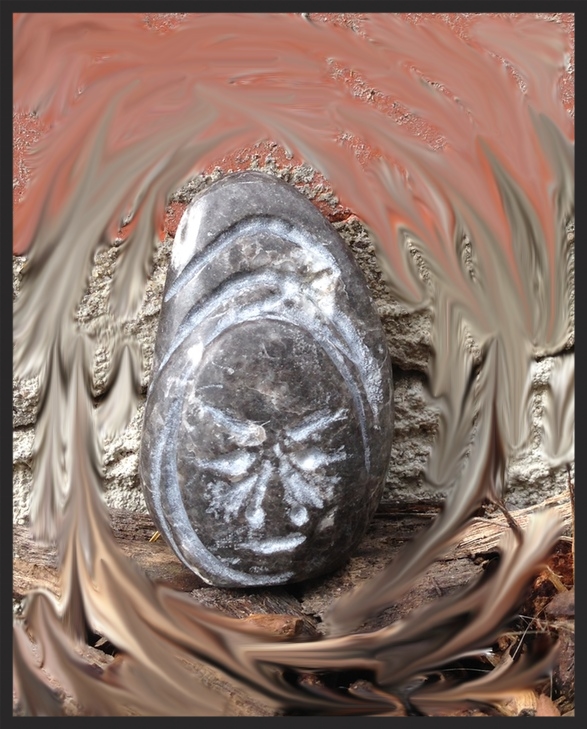Mill Creek Chroniclers Make History
Introduction: The Creek Bed Cerebrito
The Creek Bed Cerebrito carving is guided by a comparative reading of pre-Columbian Mesoamerican and Andean interpretations regarding the intricate relationship between the arc of the horizon and the “spiraling’ movement of light, water and sound. While the overall “comma-like” shape of work may give pause for reflection, the carving also marshals complimentary Eurasian and Asian insights regarding “a cosmic egg,” further exemplified by the piece’s “egg-like” head. When gently nudged in either direction the carving will spin while too much force will produce an unhappy result. The carving draws inspiration from an encounter with a family of “Mill Creek” coyotes in Edmonton’ River valley during a frosty Winter evening. The rock for the carving was quarried from banks of the Bow River in and around the environs of the boat launch and railway bridge in Canmore, Alberta in June 2015. Creek Bed Cerebrito is dedicated to the cause of education and literacy programs in Western and Northern Canada. It was presented to GCh by the School of One Carver at the fine Mill Creek establishment known as Wild Earth just before the Summer 2015 began to arrive to the North Saskatchewan River Valley and its associate ravines. Thus, the historic and historical journeys of the Creek Bed Cerebrito with GCh and RCh began.
Links:
For a highly worthwhile historical introdution to Mill Creek Ravine and its environs, please see Jan Olson's “99 St. Ribbons of History"
Memory Space Genesis: Growing Tot Lot
Originally from Montreal, GCh dedicated several years of service to Edmonton Public Schools' administration and also taught for Athabasca University. Support for education, community programs and cultural affairs in Edmonton has continued for GCh in "retirement", especially for Boyle Street programs and for inner-city Indigenous people. In this first installment, GCh reveals a commitment to local community history and how a deep-seated interest in historic community spaces are never removed from family and grandchildren.
Western Rim, Mill Creek Ravine
By the western rim of Mill Creek Ravine, near 88th Avenue and 97th Street, lies a flat expanse of land that once may have held a couple of settlers’ cabins or the shelters of Indigenous people. When we first arrived in this neighbourhood, this land was a community garden with friends growing corn and potatoes, peas and beans, carrots and cabbages. Then it was transformed into a tot lot, where our children played and grew. Now, a generation later, we play in this gathering place, this community nurturing place, with our grandchildren – on swings and slides, on the grass and in the sand, and jumping from stone boulder to boulder around the wide circle of an urban medicine wheel.
Links:
Boyle Street Community Services
Memory Space Edifice: Childhood Brick Walls
Just like GCH, RCh has given considerable time and support for community and education in Edmonton. Creek Bed proves to be very useful for not only for marking time but for retrieving memories from childhood, recollections which are further enriched by research into original newspapers found in the City Archive. RCh interest in these historical records are understandable when a vocational context is considered. While both GCh and RCh obtained graduate training at the University of Alberta, RCh continued with advanced study into political theory before returning to Edmonton and working for a prominent local newspaper for several years.
Boys Detention Home
I grew up in the Mill Creek neighbourhood but I walked or biked into Old Strathcona, on the west side of 99th Street, every day -- to King Edward School and later to Old Scona High School, to the Public Library and to the Baptist Church. They all were handsome, red brick buildings. I stayed clear of another red brick building -- the South Side Detention Home. From the outside, it just looked plain and drab. The real problems were hidden inside, as I recently learned from old newspapers at the Edmonton Archives.
In 1945, a series of stories described the Detention Home in the context of “the juvenile delinquency problem.” It was used to temporarily detain boys who then would be sent to work as farm labour, and was a more permanent residence for “incorrigible” boys who became wards of the province. For many years, it operated without public controversy – then continued for many more years despite troubling revelations. Meanwhile, in 1949, a 65-year-old employee was jailed for “a statutory offence” against boys in the Detention Home.
The sketchy history of the institution continued during the following decade. In 1951, for example, police officers picked up a 15-year-old boy at 11:10 one evening, “after curfew” and delivered him to the Detention Home, where he was held for two days without his widowed mother being notified. A Jasper Place Town Councillor said “the boy told of being cloistered with sex perverts and mentally deficient youths.” Another 1951 story reported that a supervisor resigned and revealed that 20 boys had escaped in the previous five weeks.
The Detention Home carried on until 1964 when, finally and thenkfully, it was closed after a discovery that neglected children and juvenile delinquents were being housed together, a feature of the institution which was directly at odds with the Child Welfare and Juvenile Courts Acts. Today, the building is long gone, replaced by a small park and gazebo where young people gather happily -- unaware of the site’s sad history.
Links:
To conduct online research into Alberta newspapers, please see “AHDP - Newspaper Collection Home"
For information about the municipal archive, please see “City of Edmonton Archives"




